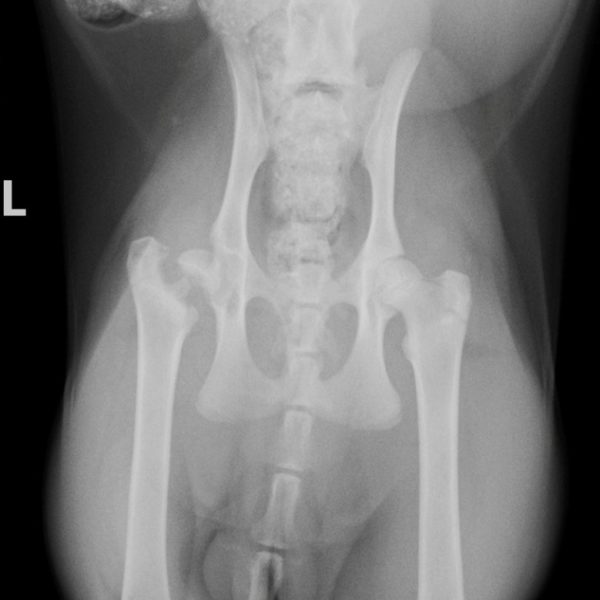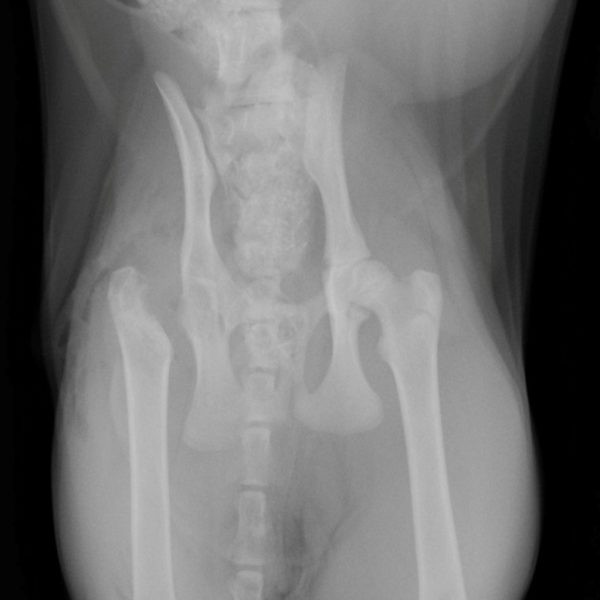Femoral Head and Neck Excision Arthroplasty
What is a femoral head and neck excision arthroplasty?
Femoral head and neck excision is a surgical procedure that is commonly performed in small animal patients.
The hip is a ball and socket joint, with the femoral head (the upper part of thigh bone) being the ball and the acetabulum (a portion of the pelvis) comprising the socket of the joint.
Femoral head and neck excision (FHNE) is a surgical procedure in which the ball portion and the attachment (neck) portion are removed from the rest of the femur, which in essence removes the hip joint, leaving just an empty socket .The thigh will stay connected to the pelvis via scar tissue and with the support from the surrounding muscles forming a “false joint”.
Although this joint is anatomically very different from a normal hip joint, it provides pain-free mobility in most patients.
Femoral head and neck excision is a salvage procedure that is done to relieve pain in the coxofemoral joint and restore acceptable function of the limb.
The procedure should not be overused and ideally should not be done when the integrity of the coxofemoral joint can be restored or when hip replacement is an option.
The most common reasons for FHNE include:
• Hip joint fractures. When a fracture involves the hip joint and cannot be repaired surgically (either due to patient considerations or financial considerations for the owner), a FHNE may provide the best option for pain-free mobility.
• Femoral neck fractures. Chronic fractures of the femoral neck where there is already established bone resorption and fracture repair is no longer possible.
• Hip luxation/dislocations. In chronic cases when the hip that is out of the socket cannot be replaced in the socket or the articular cartilage is damaged, or when surgical repair of hip luxation is not an option do to financial reason.
• Legg-Perthes disease (also known as avascular necrosis of the femoral head). This uncommon condition, most frequently seen in miniature and toy breed dogs, causes the bone within the femoral head to begin to die (necrosis) at an early age. The bone collapses due to these degenerative changes, leading to severe pain. Removing the femoral head via FHNE removes the source of pain for the dog.
• Severe hip dysplasia/arthritis of the hip.In chronic, end-stage arthritis, the cartilage that protects both the head of the femur and the acetabulum can become eroded away, leading to painful bone-on-bone grating whenever the hip is moved. Performing an FHNE can alleviate pain.
What is the post-operative care?
Care varies based on the needs of the specific patient but, in general, in contrast to many other orthopaedic surgeries, restricted activity and strict cage rest following FHNE surgery are contraindicated. After surgery, these patients must be encouraged to use the limb as early and as frequently as possible. Activity, including stair climbing etc, is very much encouraged to allow for the best possible outcome.
Many pets, will require physiotherapy, utilizing techniques such as range of motion exercises and swimming. Aggressive pain management is critical in the early postoperative period to allow early use of the limb.
See our post-op aftercare sheet for FHNE for more detail.
Outcomes
Cats and small dogs tend to have good-to-excellent functional outcome while bigger dogs tent to have more variable outcome.
Other factors that can influence postoperative outcome include age, activity levels, postoperative physical therapy, and the severity of muscle atrophy at the time of surgery.
The mean time to full recovery has been described to be around 5 weeks. However, return to maximal function following FHNE can take as long as 6 months and depends on the chronicity of disease before surgery. Surgery performed before muscle atrophy has occurred carries an improved outcome and a shorter recovery period.
What are the risks or complications?
As with any surgery there are potential risk and complication.
Although many pets function well after excision of the femoral head and neck, as with any surgery there are potential risk and complications.
Complications specific to FHNE surgery include
• Shortening of the limb
• Muscle atrophy
• Decreased range of motion of the hip, particularly on extension
• Chronic lameness
• Patellar luxation
• Damage to the large nerve running at the back of the hip joint (sciatic nerve), which may be related to the initial injury or to the surgery itself. Usually, this result in a temporary paresis/paralysis that will generally resolve in the weeks following surgery. In a small number of cases this paralysis may be permanent.
A left femoral capital physeal fracture with severe resorption of the femoral neck was identified. A fractured capital physis with minimal displacement may be difficult to detect using an extended ventrodorsal radiographic projection of the hips. The joint capsule become tightened during extension of the limb, which reduces the fracture and prevents its visualization. To avoid this problem and facilitate observation of the fracture, a “frog-legged” view can be taken
The lesser trochanter was preserved as it is the insertion of the ileopsoas muscle, an important flexor of the hip.


